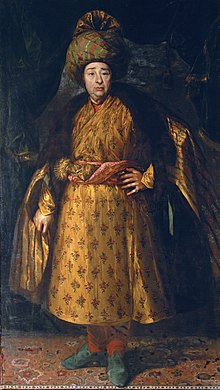Jean-Baptiste Tavernier
Appearance

Jean-Baptiste Tavernier (1605–1689)was a 17th-century French gem merchant and traveler.
Quotes
[edit]- In this country there is another pagoda, well-built and very ancient, and ornamented within and without with many figures, which are representations of girls and women only. Men never go there to worship, and on that account it is called the girls’ pagoda. It has an alter in the middle like the other pagodas, and upon this altar there is an idol of massive gold about 4 feet high, which represents a girl, standing, whom they call Ram-Marion. She has on her right an image of a child, standing, made of massive silver, and nearly 2 feet in height, and it is said that this girl living a holy life, the infant was taken to her by the Brahmans to learn her creed and how to live well; but at the end of three or four years, during which the child had dwelt with the girl, it became so clever and accomplished that all the Rajas and Princes of the county wished for it, and, at last, one of them carried it off one night and it has not since. This idol has on her left, at the base of the altar, another idol representing an old man, whom they say had been the servant of Ram-Marion and the child, and the Brahmans pay great reverence to this idol. They come to it only once a year for worship, and it is necessary for them to arrive on a prescribed day, which is the first day of the moon in November, because the pagoda is only opened at full moon. During the fifteen days which intervene all the pilgrims, both men and women, must fast at times, and bathe three times everyday, without leaving a single hair on their bodies, all being easily removed by the use of a certain earth with which they rub themselves [use of lime and arsenic and depilatories. (Vol. II, pp. 238-39)
- Jean Baptiste Tavernier’s book ‘Travels in India, quoted in Kishore, Kunal (2016). Ayodhyā revisited. ch. 12
- Ahmadabad is one of the largest towns in India, and there is a considerable trade in silken stuffs, gold and silver tapestries, and others mixed with silk ; saltpetre, sugar, ginger, both candied and plain, tamarinds, mirabolans, and indigo cakes, which are made at three leagues from Ahmadabad, at a large town called Suarkei.There was formerly a pagoda in this place, which the Musalinans seized and converted into a mosque. Before entering it you traverse three great courts paved with marble, and surrounded by galleries, but you are not allowed to place foot in the third without removing your shoes. The exterior of the mosque is ornamented with mosaic, the greater part of which consists of agates of different colours, obtained from the mountains of Cambay, only two days’ journey thence.
- Description of the temple built by Shantidas Jhaveri. Travels In India Vol.-i by Tavernier Jean-baptiste [1] Cited in Harsh Narain, The Ayodhya Temple Mosque Dispute: Focus on Muslim Sources, Appendix VI
- At the first establishment of Islam in India the Christians of the East were very ostentatious (estoient fort superbes) but not very devout, and the Idolaters were effeminate people unable to make much resistance. Thus it was easy for the Musalmans to subject both by force of arms. This they did with so much success that many Christians and Idolaters embraced the Law of Muhammad.
- Tavernier, Jean-Baptiste, Travels in India, Ed., William Crooke, Low Price Publications, 2000. III:137ff quoted from Jain, M. (editor) (2011). The India they saw: Foreign accounts. New Delhi: Ocean Books. Volume III Chapter 15
- I have elsewhere remarked that among the native Musalman subjects of the Great Mogul there are but few in positions of command; this is the cause why many Persians, oppressed by want, or ambitious of better fortune than they can hope for in their own country, go to seek for it in India. Being clever they are successful in finding means to advance themselves in the profession of arms, so that in the Empire of the Great Mogul as well as in the Kingdoms of Golkonda and Bijapur, the Persians are in possession of the highest posts.
- Tavernier, Jean-Baptiste, Travels in India, Ed., William Crooke, Low Price Publications, 2000. III:137ff quoted from Jain, M. (editor) (2011). The India they saw: Foreign accounts. New Delhi: Ocean Books. Volume III Chapter 15
- Under the cover of the fact that the rulers are Muslims, they persecute these poor idolaters to the utmost and if any of the latter becomes Muslim, it is in order not to work any more.
- Tavernier, as quoted from Sharma Sri Ram. 1988. The Religious Policy of the Mughal Emperors. 3rd ed. New Delhi: Munshiram Manoharlal. ch 10

